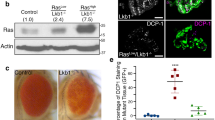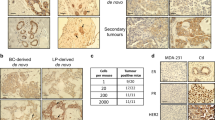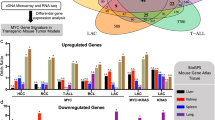Abstract
Activation of the NF-κB pathway can either promote or block apoptosis and oncogenesis in different cell types and circumstances. In this report, we show that independently derived immortalized mouse embryonic fibroblast cell lines prepared from RelA knockout mice have different phenotypes, based on their sensitivity to tumor necrosis factor α (TNFα)-induced apoptosis, morphology, ability to form colonies in soft agar, and the presence of distinct κB site-binding complexes. In addition, these RelA-deficient cell lines appear to have distinct alterations in the p53 pathway, which correlate with the normal vs transformed status of individual cell lines. We have also infected mouse embryonic fibroblasts lacking RelA, c-Rel or p50 with a retrovirus for the expression of v-Ha-Ras to determine whether individual NF-κB family members are required for Ras-mediated transformation. All three NF-κB-deficient cell types could be transformed by v-Ha-Ras. However, v-Ras-infected RelA-deficient cells formed colonies in soft agar at an approximately fourfold reduced efficiency compared to v-Ras-transformed control mouse 3T3 and p50-deficient cells. Ras transformation did not alter the sensitivity of RelA-deficient cells to TNFα-induced apoptosis, and Ras transformation did not affect the general resistance of 3T3, c-Rel-deficient, and p50-deficient cells to TNFα-induced apoptosis. However, TNFα specifically and dose-dependently decreased the ability of v-Ras-transformed RelA-deficient cells to form colonies in soft agar. These results suggest that RelA is a potential protein target for human tumors driven by oncogenic Ras mutations, but caution that inhibition of RelA may promote tumorigenesis in some circumstances.
This is a preview of subscription content, access via your institution
Access options
Subscribe to this journal
Receive 50 print issues and online access
$259.00 per year
only $5.18 per issue
Buy this article
- Purchase on Springer Link
- Instant access to full article PDF
Prices may be subject to local taxes which are calculated during checkout








Similar content being viewed by others
References
Aaronson SA and Todaro GJ . (1968). J. Cell. Physiol., 72, 141–148.
Aguilera C, Hoya-Arias R, Haegeman G, Espinosa L and Bigas A . (2004). Proc. Natl. Acad. Sci. USA, 101, 16537–16542.
Alarcon-Vargas D and Ronai Z . (2002). Carcinogenesis, 23, 541–547.
Alcamo E, Mizgerd JP, Horwitz BH, Bronson R, Beg AA, Scott M, Doerschuk CM, Hynes RO and Baltimore D . (2001). J. Immunol., 167, 1592–1600.
Ayrault O, Andrique L, Larsen C-J and Seite P . (2004). Oncogene, 23, 8097–8104.
Baldwin Jr AS . (2003). Nuclear Factor κB: Regulation and Role in Disease Beyaert R (ed). Kluwer Academic Publishers: The Netherlands, pp 393–408.
Beg AA and Baltimore D . (1996). Science, 274, 782–784.
Brown K, Gertsberger S, Carlson L, Franzoso G and Siebenlist U . (1995). Science, 267, 1485–1488.
Campbell SL, Khosravi-Far R, Rossman KL, Clark GJ and Der CJ . (1998). Oncogene, 17, 1395–1413.
Chang NS . (2002). J. Biol. Chem., 277, 10323–10331.
Dajee M, Lazarov M, Zhang JY, Cai T, Green CL, Russell AJ, Marinkovich MP, Tao S, Lin Q, Kubo Y and Khavari PA . (2003). Nature, 421, 639–643.
Deng J, Miller SA, Wang H-Y, Xia W, Wen Y, Zhou BP, Li Y, Lin S-Y and Hung M-C . (2002). Cancer Cell, 2, 323–334.
DiDonato J, Mercurio F, Rosette C, Wu-Li J, Suyang H, Ghosh S and Karin M . (1996). Mol. Cell. Biol., 16, 1295–1304.
Doi TS, Marino MW, Takahashi T, Yoshida T, Sakakura T, Old LJ and Obata Y . (1999). Proc. Natl. Acad. Sci. USA, 96, 2994–2999.
Feig LA, Pan BT, Roberts TM and Cooper FM . (1986). Proc. Natl. Acad. Sci. USA, 83, 4607–4611.
Fernandez A, Marin MC, McDonnell T and Ananthaswamy HN . (1994). Oncogene, 9, 2009–2017.
Finco TS and Baldwin Jr AS . (1993). J. Biol. Chem., 268, 17676–17679.
Finco TS, Westwick JK, Norris JL, Beg AA, Der CJ and Baldwin Jr AS . (1997). J. Biol. Chem., 272, 24113–24116.
Gapuzan M-ER, Yufit PV and Gilmore TD . (2002). Oncogene, 21, 2484–2492.
Gilmore TD, Kalaitzidis D, Liang M-C and Starczynowski DT . (2004). Oncogene, 23, 2271–2282.
Hanson JL, Anest V, Reuther-Madrid J and Baldwin Jr AS . (2003). J. Biol. Chem., 278, 34910–34917.
Hanson JL, Hawke NA, Kashatus D and Baldwin Jr AS . (2004). Cancer Res., 64, 7248–7255.
Hayden MS and Ghosh S . (2004). Genes Dev., 18, 2195–2224.
Hoffmann A, Leung TH and Baltimore D . (2003). EMBO J., 22, 5530–5539.
Jeay S, Pianetti S, Kagan HM and Sonenshein GE . (2003). Mol. Cell. Biol., 23, 2251–2263.
Jo H, Zhang R, Zhang H, McKinsey TA, Shao J, Beauchamp RD, Ballard DW and Liang R . (2000). Oncogene, 19, 841–849.
Joneson T and Bar-Sagi D . (1997). J. Mol. Med., 75, 587–593.
Kucharczak J, Simmons MJ, Fan Y and Gélinas C . (2003). Oncogene, 22, 8961–8982.
Li J, Joo SH and Tsai MD . (2003). Biochemistry, 42, 13476–13483.
Loop T and Pahl HL . (2003). Nuclear Factor κB: Regulation and Role in Disease Beyaert R (ed). Kluwer Academic Publishers: The Netherlands, pp 1–48.
Lowy DR and Willumsen BM . (1993). Annu. Rev. Biochem., 62, 851–891.
Lundberg AS, Hahn WC, Gupta P and Weinberg RA . (2000). Curr. Opin. Cell Biol., 12, 705–709.
Mayo MW, Norris JL and Baldwin Jr AS . (2001). Methods Enzymol., 333, 73–87.
Mayo MW, Wang C-Y, Cogswell PC, Rogers-Graham KS, Lowe SW, Der CJ and Baldwin Jr AS . (1997). Science, 278, 1812–1815.
Morgenstern JP and Land H . (1990). Nucleic Acids Res., 18, 3587–3596.
Pando MP and Verma I . (2000). J. Biol. Chem., 275, 21278–21286.
Qi Y, Gregory MA, Li Z, Brousal JP, West K and Hann SR . (2004). Nature, 431, 712–717.
Reuther JY, Reuther GW, Cortez D, Pendergast AM and Baldwin Jr AS . (1998). Genes Dev., 12, 968–981.
Rocha S, Campbell KJ and Perkins ND . (2003). Mol. Cells, 12, 15–25.
Rocha S, Garrett MD, Campbell KJ, Schumm K and Perkins ND . (2005). EMBO J., 24, 1157–1169.
Rosenfeld ME, Prichard L, Shiojiri N and Fausto N . (2000). Am. J. Pathol., 156, 997–1007.
Sigal A and Rotter V . (2000). Cancer Res., 60, 6788–6793.
Suzuki J, Sukezane T, Akagi T, Georgescu MM, Ohtani M, Inoue H, Jat PS, Goff SP, Hanafusa H and Shishido T . (2004). Oncogene, 23, 8527–8534.
Tergaonkar V, Pando M, Vafa O, Wahl G and Verma I . (2002). Cancer Cells, 1, 493–503.
Van Antwerp DJ, Martin SJ, Kafri T, Green DR and Verma I . (1996). Science, 274, 787–789.
van Hogerlinden M, Rozell BL, Ährlund-Richter L and Toftgård R . (1999). Cancer Res., 39, 3299–3303.
Waldman T, Kinzler KW and Vogelstein B . (1995). Cancer Res., 55, 5187–5190.
Wang C-Y, Cusack JC, Liu R and Baldwin Jr AS . (1999). Nat. Med., 5, 412–417.
Zhang JY, Green CL, Tao S and Khavari PA . (2004). Genes Dev., 18, 17–22.
Zhou M, Gu L, Zhu N, Woods WG and Findley HW . (2003). Oncogene, 22, 8137–8144.
Zong W-X, Bash J and Gélinas C . (1998). Cell Death Differ., 5, 963–972.
Acknowledgements
We thank Demetrios Kalaitzidis and Naomi Rosenberg for helpful discussions. We thank Mark Hannink for c-rel−/− fibroblasts, and Amer Beg for nfkb1−/− fibroblasts, Youssef Jounaidi for Bosc23 retrovirus-packaging cells, Nancy Rice for antibody to mouse RelA (to TDG), and Steve Tronick for NF-κB antibodies (to AH). This work was supported by NIH grant CA47763 (to TDG). AH thanks David Baltimore for generous support during the course of this work. ADP was partially supported by funds from the Boston University Undergraduate Research Opportunities Program.
Author information
Authors and Affiliations
Corresponding author
Rights and permissions
About this article
Cite this article
Gapuzan, ME., Schmah, O., Pollock, A. et al. Immortalized fibroblasts from NF-κB RelA knockout mice show phenotypic heterogeneity and maintain increased sensitivity to tumor necrosis factor α after transformation by v-Ras. Oncogene 24, 6574–6583 (2005). https://doi.org/10.1038/sj.onc.1208809
Received:
Revised:
Accepted:
Published:
Issue Date:
DOI: https://doi.org/10.1038/sj.onc.1208809
Keywords
This article is cited by
-
Quercetin inhibits prostate cancer by attenuating cell survival and inhibiting anti-apoptotic pathways
World Journal of Surgical Oncology (2018)
-
Regulation of SET Gene Expression by NFkB
Molecular Neurobiology (2017)
-
IκBβ enhances the generation of the low-affinity NFκB/RelA homodimer
Nature Communications (2015)
-
NF-κB controls energy homeostasis and metabolic adaptation by upregulating mitochondrial respiration
Nature Cell Biology (2011)
-
Cross talk between stimulated NF-κB and the tumor suppressor p53
Oncogene (2010)



